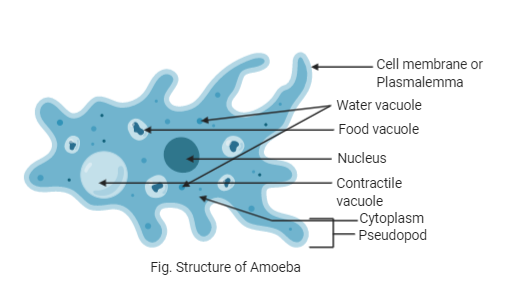
Amoeba sticks to the substratum by means of
A. Rough surface
B. Plasmalemma
C. Protein
D. None of the above
Answer
548.7k+ views
Hint: Amoeba is a unicellular protozoan found in ponds with irregular shapes. Amoeba shows creeping movement in which it produces pseudopodia. This is known as an amoeboid movement.
Complete answer: Amoeba is a unicellular organism that has an irregular shape. They are usually found in still water bodies like ponds, lakes, etc. Amoeba contains a cell membrane, cytoplasm, nucleus, food vacuoles, and contractile vacuoles. Amoeba moves by the means of pseudopodia (meaning false legs) that are the extended part of the cell membrane. It also helps amoeba to catch preys. The body of amoeba that is the cytoplasm and cell membrane flows around the food particle and engulfs it forming food vacuoles. Reproduction in amoeba is done by fission or sporulation.

Whenever amoeba moves it extends its cytoplasm and cell membrane (also known as the plasmalemma) forward which leads to the formation of pseudopodia that helps the amoeba to stick to the surface or substratum. This process is known as extension.
Hence, the correct answer is option B.
Note: Vacuoles present in amoeba are said to be the storage unit of the cell. Contractile vacuoles can change the shape according to their needs. In amoeba, vacuoles help in removing waste present in the body. Food captured by amoeba is also present in the form of food vacuole.
Complete answer: Amoeba is a unicellular organism that has an irregular shape. They are usually found in still water bodies like ponds, lakes, etc. Amoeba contains a cell membrane, cytoplasm, nucleus, food vacuoles, and contractile vacuoles. Amoeba moves by the means of pseudopodia (meaning false legs) that are the extended part of the cell membrane. It also helps amoeba to catch preys. The body of amoeba that is the cytoplasm and cell membrane flows around the food particle and engulfs it forming food vacuoles. Reproduction in amoeba is done by fission or sporulation.

Whenever amoeba moves it extends its cytoplasm and cell membrane (also known as the plasmalemma) forward which leads to the formation of pseudopodia that helps the amoeba to stick to the surface or substratum. This process is known as extension.
Hence, the correct answer is option B.
Note: Vacuoles present in amoeba are said to be the storage unit of the cell. Contractile vacuoles can change the shape according to their needs. In amoeba, vacuoles help in removing waste present in the body. Food captured by amoeba is also present in the form of food vacuole.
Recently Updated Pages
Why are manures considered better than fertilizers class 11 biology CBSE

Find the coordinates of the midpoint of the line segment class 11 maths CBSE

Distinguish between static friction limiting friction class 11 physics CBSE

The Chairman of the constituent Assembly was A Jawaharlal class 11 social science CBSE

The first National Commission on Labour NCL submitted class 11 social science CBSE

Number of all subshell of n + l 7 is A 4 B 5 C 6 D class 11 chemistry CBSE

Trending doubts
10 examples of friction in our daily life

One Metric ton is equal to kg A 10000 B 1000 C 100 class 11 physics CBSE

Difference Between Prokaryotic Cells and Eukaryotic Cells

1 Quintal is equal to a 110 kg b 10 kg c 100kg d 1000 class 11 physics CBSE

State the laws of reflection of light

Explain zero factorial class 11 maths CBSE




